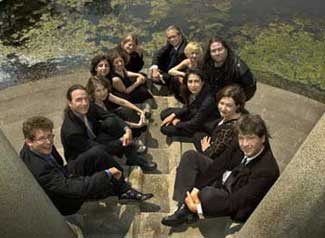Classical Concert Review: Chameleon Arts Ensemble Heads North
Ms. Bolden’s goal of evoking wintry climes was achieved because of her choice of pieces and musicians, who performed these compositions so well.
Chameleon Arts Ensemble. At the Goethe Institut, Boston, MA, February 4 and 5, 8 p.m.
By Susan Miron
Chameleon Arts Ensemble of Boston, under Artistic Director and flutist Deborah Bolden, has a lot going for it —a lovely place to perform (either Goethe Institut or the First Church, Boston, down the street), excellent musicians, and unusually interesting programming. Both performances last weekend took place at the Goethe Institut.
This concert’s theme, “by the north-wind sent,” was inspired by Glenn Gould’s radio documentary The Idea of North, in which, Ms. Bolden writes,
“He sought to explore the solitude and spirit of the northern reaches of his native Canada. I wondered, ‘what does ‘north’ sound like?” This concert, then, is her attempt “to create a musical portrait of the qualities that I think make the northern reaches so beautiful—sounds that evoke the beauty and impenetrability of the landscape, longing, solitude, myths and legends.”
All of the pieces—for an unusually varied combination of players—were written by composers from Northern European countries—Wales, Finland, Norway, the British Isles, and Denmark. Ms. Bolden’s goal of evoking wintry climes was achieved because of her choice of pieces and the performers, who executed these compositions so well.
The first set of pieces, the rarely heard Four Pieces for violin or cello, Op. 78 (1915–1916) by Jean Sibelius were played exquisitely by cellist Rafael Popper-Keizer and pianist Christopher Guzman. The second movement, Romance, was given a beautiful performance, as was the darker third movement, Religioso, played with the soulfulness so well suited to the cello. Religioso was dedicated to his brother Christian, a cellist, who at the time was recovering from a serious illness.
I looked forward to hearing the next piece, “From the Song of Amergin” (1995) by the Welsh composer Hilary Tann (born 1947), because I have always been intrigued music for a flute, viola, and harp trio. There have been a spate of new pieces written for the instrumentation of the Debussy Trio, but this is surely one of the best of them. Ms. Tann really knew how to write for the harp (every composer knows how to write for flute and viola!).
Also, a love of nature inspires her music.The composer writes, “‘From the Song of Amergin’ is in five sections, played without a break. Three lines from an ancient calendar-alphabet, the ‘Song of Amergin,’ directly inspired the piece: ‘I am the wind: on a deep lake, I am a tear: the sun lets fall, I am a hawk” above the cliff.’ The three inner sections are shaped like the lines of the poem—the harp is featured in wind/lake, the viola in tear/sun, and the flute in hawk/cliff.”
The writing for each of the outstanding players (flutist Deborah Bolden, violist Scott Woolweaver, viola, and harpist Anna Reinersman) was very effective and played with great brio. They were actually persuasive in dramatizing the natural forces suggested by their parts, especially the harp in the wind/lake. It’s a good piece that I would love to hear again.
Next up was the Piano Trio: A Voyage to Fair Isle by Peter Maxwell Davis (born 1934) written in 2002 for the Grieg Trio of Norway. Played by the wonderful violinist Joanna Kurkowicz, Rafael Popper-Keizer, and pianist Christopher Guzman, this is an enchanting work full of haunting melodies, another piece I would like to hear again. The performance was excellent, and that was not surprising given the caliber of the musicians.
The first piece after intermission was the famous Wind Quintet by Carl Nielsen (1865–1931) played by flutist Deborah Boldin, oboist Nancy Dimock, clarinetist Kelli O’Connor, bassoonist Margaret Phillips, and French hornist Whitacre Hill. Nielsen was interested in creating a portrait of each instrument, which he did in various solos for each. If you are ever in a woodwind quintet, you will doubtless have this piece in your repertoire. And if you like woodwinds, this is a piece to you will want to hear.
The last composition of the evening was well worth the wait— Edvard Grieg’s (1843–1907) lovely Sonata No. 3 in c minor, Op 45, full of dramatic tension, urgency, and striking beauty. It was given a gorgeous performance by violinist Joanna Kurkowicz (always worth hearing) and pianist Christopher Guzman. I wasn’t familiar with this piece and was quite thrilled to make its acquaintance. One small quibble—the program notes tell us that, “hailed by critics and the public, it quickly entered the repertories of Wieniawski, Ysaÿe, Kreisler, and other leading violinists.” Alas, the piece was premiered in 1887; Wieniawski died in 1880.
Tagged: Chamber music, Chameleon Arts Ensemble, by the north-wind sent


